2004 VOLKSWAGEN GOLF PLUS load capacity
[x] Cancel search: load capacityPage 142 of 541
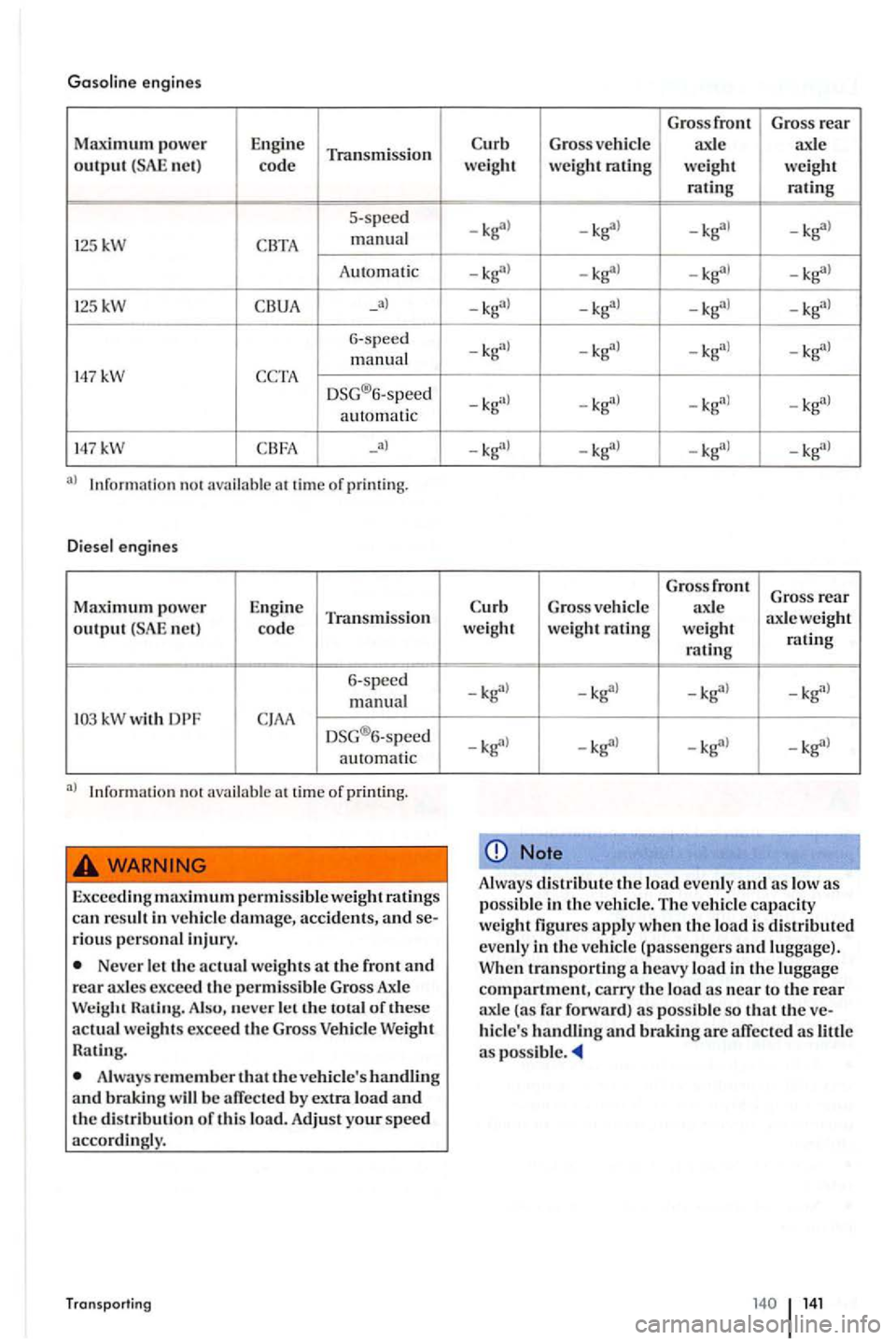
Gasoline engines
Maximum power Eng in e
Transmission output ne t)
code
5-speed
1 25kW
manual
A utomati c ---125kW _a)
6-speed
m anual
1
47kW cerA DSG® 6-speed autom atic
1 47kW
I nforma tio n not availab le
n et) code Transmission
6-speed manual
Exceed
ing m aximum permiss ibl e w eight ratin gs
ca n
Neve r let th e actual weights at the front and rea r ax les excee d th e permissible Gross Axle
remember that the ve hicle's handling and braking will be affected by extra load and the distributi on of thi s load. Adju st your s peed accordin gly.
Transporting
G ross front Gross rear
weig ht
weight ratin g weight weight
rating rating
--
---
-kg"l
Gross front
Gross rear G ross veh icle
axle
axle weight
weight weight rating weight
rating rating
-
Note
A
lwa ys distribute th e eve nly and as low as possib le in the vehicle. The ve hicl e capacity
weight figures appl y when the lo ad i s distributed
eve nly
141
Page 143 of 541
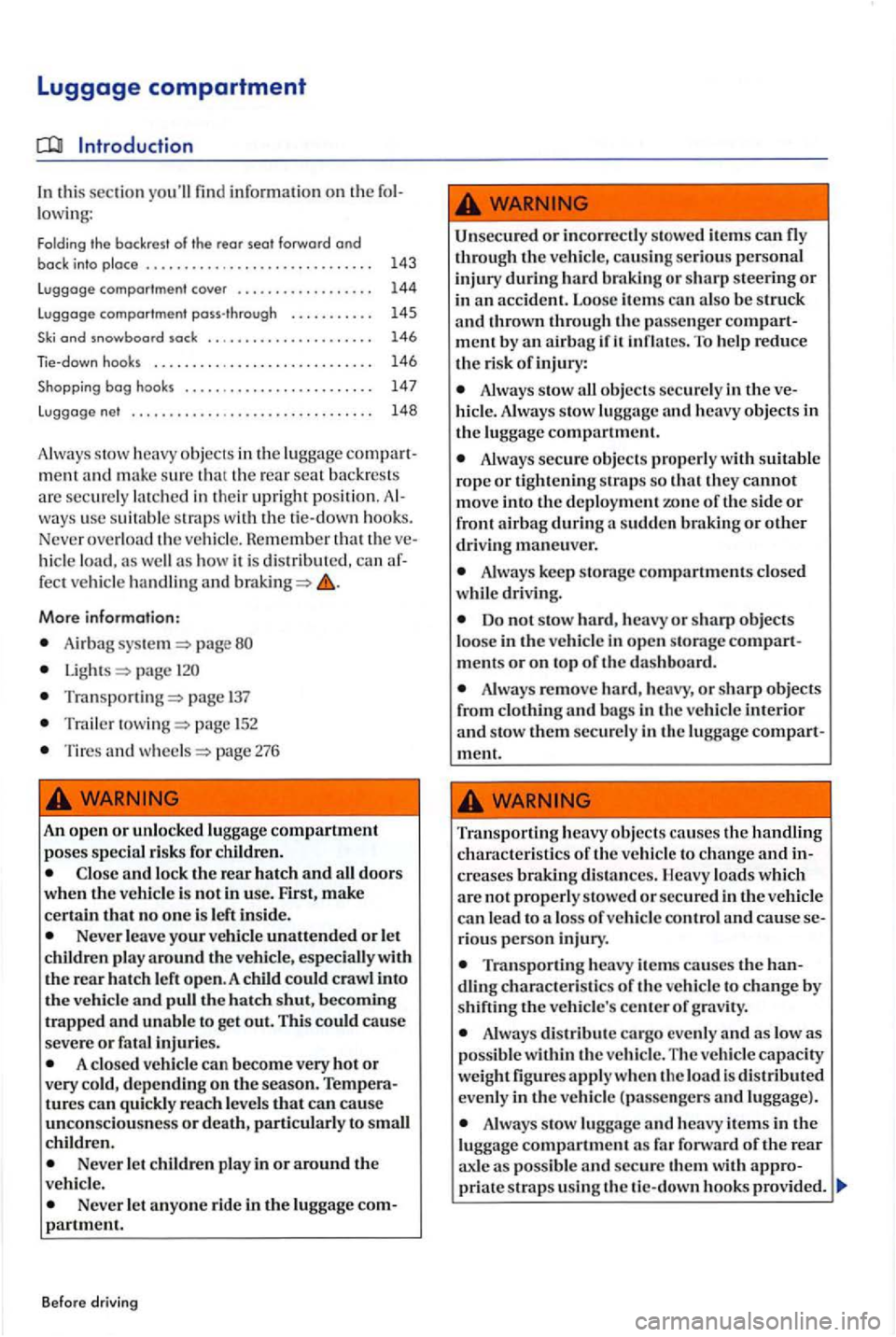
Luggage compartment
Introduction
In this section you'll fin d info rmation on the lowi ng:
Folding the backrest of the rear seat forward and back into place . . . . . . . . . . . . . . . . . . . . . . . . . . . . . . 143
Luggage compartment cover . . . . . . . . . . . . . . . . . . 144
Luggage compartment pass-through . . . . . . . . . . 145
. . . . . . . . . 146
bag hooks . . . . . . . . . . . . . . . . . . . . . . . . . 14 7
Luggage ne t . . . . . . . . . . . . . . . . . . . . . . . . . . .
. . . . 148
A lways stow h eavy objects in the luggage ment and mak e sure tha t th e rear se at back res ts
a re sec urely la tc h ed in their u pright positio n. strap s with the ric- dow n h ooks.
Never ove rload the ve hicle . Remember th at the hi cle load, well it is di str ibu te d , ca n
More info rmation:
A irbag pag e
page
page 137
Trail er page 152
Tires and pa ge 276
An open or unlocked luggage compartment poses sp eci al risks for children. C lose and lock the rear hatch and all doors when the vehicle is not in use. First, make certain that n o one is left insid e. Neve r leave your vehi cle unattende d or l et
childre n play around the ve hicl e, especi ally with the rear h atch left open. A child could crawl into the ve hicl e and pull the hatc h shut, b ecoming trapped and unable to ge t out. Thi s could cause severe or fatal injuries. A clo sed vehicl e can becom e very ho t or very cold, dependin g on the season. tures can quickly re ac h l eve ls that can cau se unconscio usness or death, particul arl y to sm all childr en . N eve r le t childr en play in or around the
veh icle .
Neve r let anyone ride in the lu ggag e partment.
Before driving
Unsecured or incorrec tl y stowe d item s can through the ve hicle, causing seriou s personal injury during hard brakin g or sh arp steering or in an acci dent. Loose item s can als o be s truck
and thrown throug h th e pa sse nger
Always sto w all objec ts sec ure ly in the
Always secu re objec ts prope rly w ith suit abl e
rop e or tightening s traps so that th ey cannot move into the deploy ment zo ne of the side o r
front airbag during a sudden braking or other driving maneu ve r.
Always kee p storage co mpartm ents clo sed
while driving.
Do not sto w hard , h eavy or sh arp objec ts
loo se in the vehicl e in open storage ments or o n to p of the dashboard.
A lways re m ove hard, heavy, or sharp objects
fr o m clothing and ba gs in the vehicl e int erio r
a nd sto w them secure ly in the lu ggage ment.
Tra nsportin g heavy objects causes the handling
c h arac teris tics of th e vehicl e to change and creases braking dista nces. Heavy loads wh ic h are n o t properly stowed or secured in tl1e vehicl e
can l ead to a loss of ve hicle control and cau se ri ous person injury.
T ra nsporting heavy item s ca uses the d ling characteris tic s of the vehicle to change by
s hiftin g the veh icle 's cen te r of g rav ity .
Alwa ys distribute ca rgo eve nly and as lo w as possibl e within the ve hicl e. The vehicl e capacity
we ig ht figures appl y w hen the load is distribute d
even ly in th e ve hicl e (p asse ngers and lugg age).
Alwa ys sto w lugg age and h eavy it e m s in the
lu ggage compartment as far fo n va rd of tl1e rear
axl e as poss ible and secure th em with priate strap s u sin g th e tic- dow n h ooks provided .
Page 156 of 541
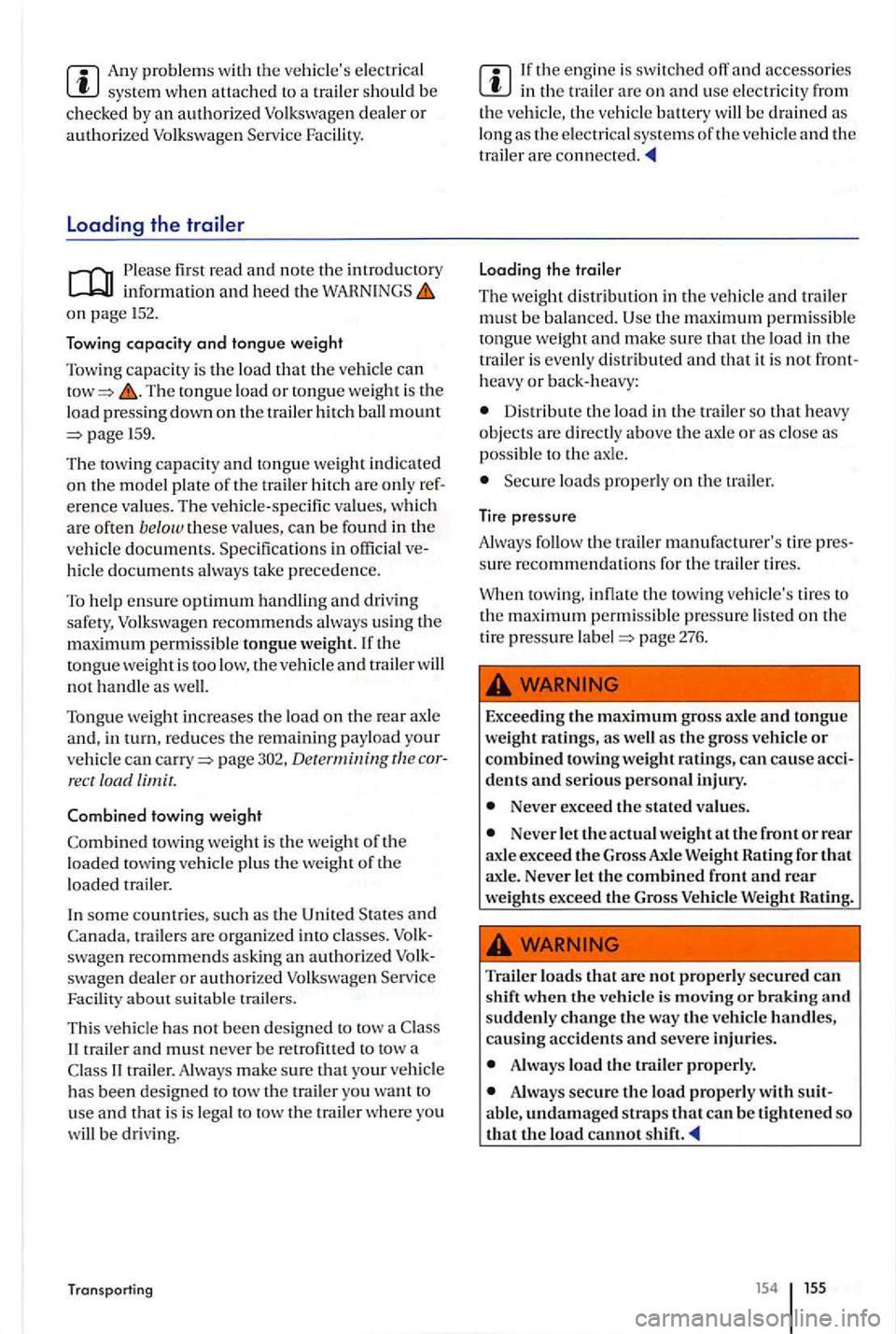
Any problems with the vehicle's elec trica l system when attached to a trailer should be chec ked by an authorized Volkswagen dealer or authorized Volkswagen Service Facility.
Loading the trailer
Pleas e first read and note the introductory information and heed the on page 152.
Towing capacity and tongue weight
Towing capac ity is the load that th e vehicle can
159.
The towing capacity and tongue weigh t indicated on the model plate o f the trail er hit ch are only re f
e ren ce value s. The vehicle-specific values, which are often below these values, can be found in the vehicle document s. Specificat ions in officia l ve
hicl e documents alwa ys take precedence.
To help en sure optimum handling and driving safe ty, Volkswagen recommends always using the
not handle as well.
Tongue weight increases the load on the rear axle and, in turn, reduces the remaining pay load your ve hicl e can cor
rect load limit.
Combined towing weight
towing weight is th e we ight of the
l oaded tow in g vehicle plus th e we igh t of th e
l oaded trailer.
In some countries, su ch a s th e States and Ca nada, trailer s are organ ize d in to cla sses. swagen recommend s askin g an authori zed swage n dealer or auth orized Volksw agen Se rvice
Facili ty about suitabl e trailer s.
Thi s
vehicle has not been desig n ed to tow a traile r and must n eve r be retrofitted to tow a II trailer. Always make sure that your vehicl e has been designed to tow the trai le r you want to use and that is is legal to tow the traile r where you be driving.
T ronsporting
Loading the trailer
The weig ht dist ribution in the vehicle and tra iler
mu st be balanced. th e maximum permissible
tongue weight and make sure that the load in the
trail er i s eve nly di stributed and that it is not front
h eavy or back-heavy:
Distribut e th e load in th e trail er so that heavy objec ts are directly above the axl e or as close as
po ssibl e to the
Secu re load s properly on the trail er.
Tire pressure
Always follow th e trail er manufac turer' s tir e pres
s ure recommendations fo r the trailer tires.
W h
en towing, inflat e th e towin g vehicl e's tir es to the maximum permissible press ure listed on th e
tir e pressure la bel pag e 276.
Exceeding
the maximum gross axle and tongue weight ratings, as well as the gross vehicle or combined towing weight ratings, can cause accidents and serious personal injury.
Never exceed the stated va lues.
Never let the actual weight at the front or rear axle exceed the Gross Axle Weight Rating for that
axle. Never let the combined front and rear weights exceed the Gross Vehicle Weight Rating.
Trailer loads
that are not properl y secured can shift when the vehicl e is moving or braking and suddenly change the way the vehicle handles,
causing accidents and severe injuries.
Always load the trailer properly.
Always secure the load properly with suitable, undamaged straps that can be tightened so that th e load cannot shift.
154 155
Page 294 of 541
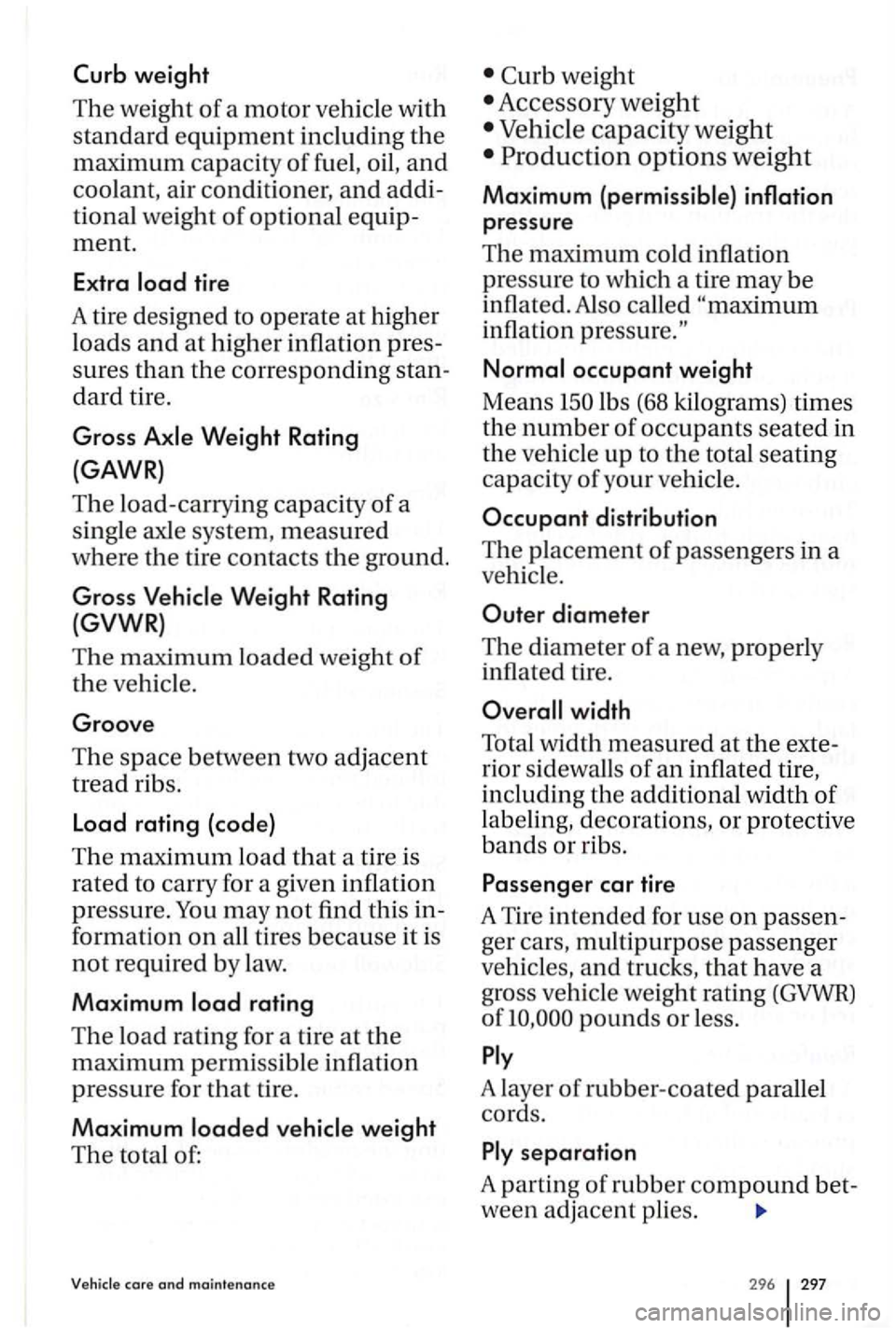
Curb weight
The weight of a motor vehicle with
standard equipment including the
maximum capacity of fuel, oil, and
coolant, air conditioner, and addi
tional weight
of optional equip
ment.
Extra load tire
A tire designed to operate at higher
lo
ads and at higher inflation pres
sures than the corresponding stan
dard tire.
Gross Axle Weight Rating
(GAWR)
The load-carryin g capacity of a
single axle system, measured
where the tire contacts the ground.
Gross
The maximum loaded weight of
the vehicle.
Groove
The space between two adjacent
tread rib s.
Load rating (code)
The maximum load that a tir e is
rated to carry for a given inflation
pressure.
You may not find this in
formation on all tires because it is
not required by law.
Maximum load rating
The load rating for a tire at the
maximum permissible inflation
pressure for
that tire.
Maximum loaded vehicle weight
The total of:
Curb weight
Accessory weight
Vehicle capacity weight
Production options weight
Maximum (permissible) inflation
pressure
The maximum cold inflation
pressure
to whic h a tire may be
inflated.
Also ca lled
inflation
Normal occupant weight
Means 150 lbs (68 kilograms) times
the number of occupants seated in
the veh icle
up to the total seating
capacity
of your vehicle.
Occupant distribution
The placement of passengers in a
veh icle.
pounds or less.
Ply
A layer of rubber- coated parallel
cords.
Ply separation
A parting of rubber compound bet-
ween adjacent plies.
296 297
Page 297 of 541
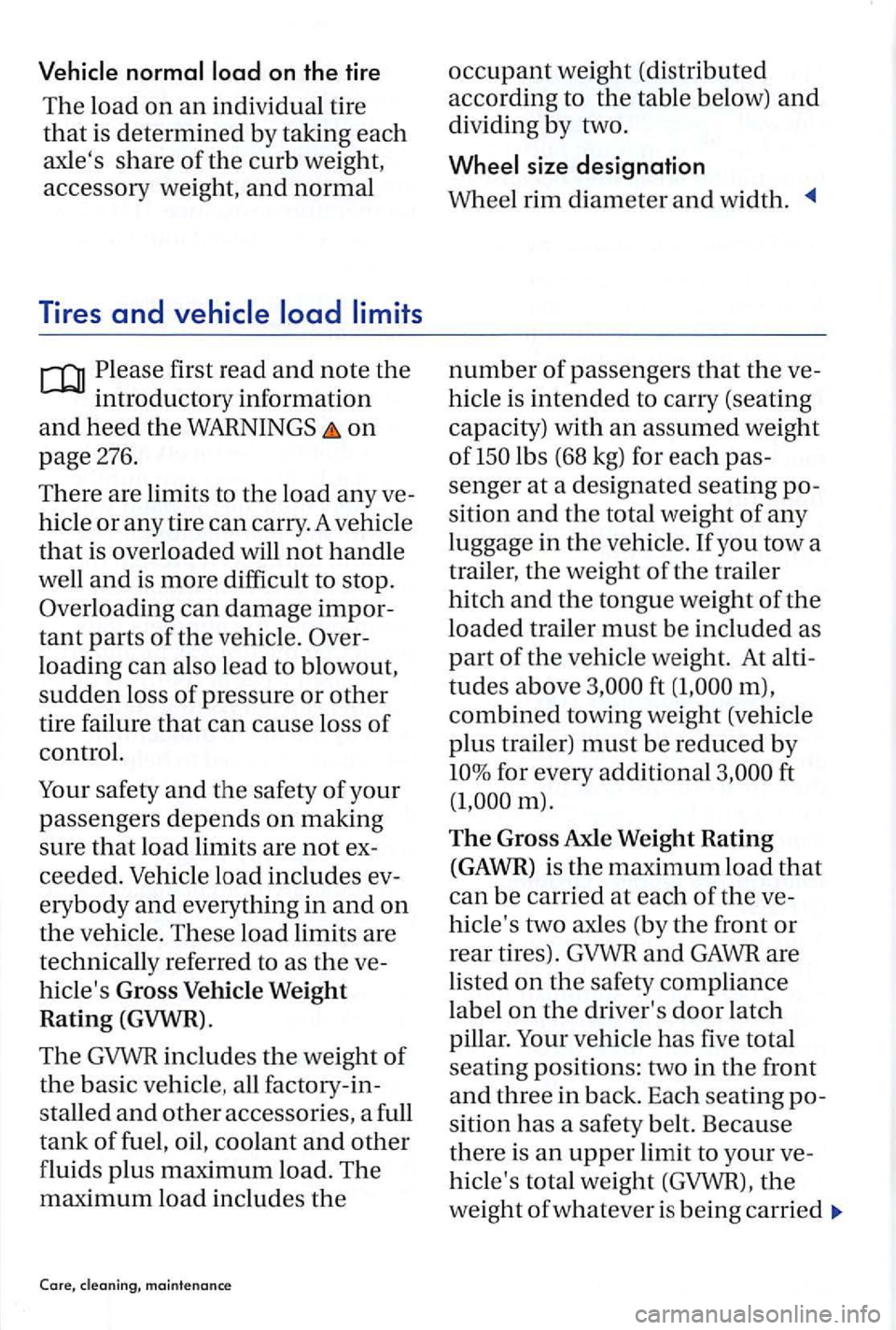
first read and note the
mtroductory information
and hee d the on
page 276.
There
are limit s to the load any ve
hicl e
or any tire can carry. A vehicle
that is ov erlo ad ed will not h andle
well and is more diffi cult to stop.
Overloading
can d am age impor
tant parts of the ve hicle.
loading can also lead to blowout,
s
udden lo ss of press ure or other
tire failur e that can cause loss of
control.
Your safety and the safety of your
passengers depends on making
sure that load limits are not ex
ceeded. Vehicle load includes ev
e rybody
and everything in and on
the ve hicl e. These load limit s are
technically refe rr
ed to as the ve
hicl
e's Gross Vehicle Weight
Rating (GVWR).
The GVWR includes the weight of
the bas ic vehicle , a ll factory-in
s tall
ed and other accessories, a full
tank of fu el, oil, coo lant and other
fluids
plus m aximum load. The
maximum load includes the
Cor e,
size designation
Wheel rim diamete r and widt h.
number of passengers that the ve
hicl e is
intended to carry (seating
capacity) with an assumed weight
of
ft m),
c
ombine d towin g weight (vehicle
plus trail er) must b e reduced by
for eve ry
Page 299 of 541
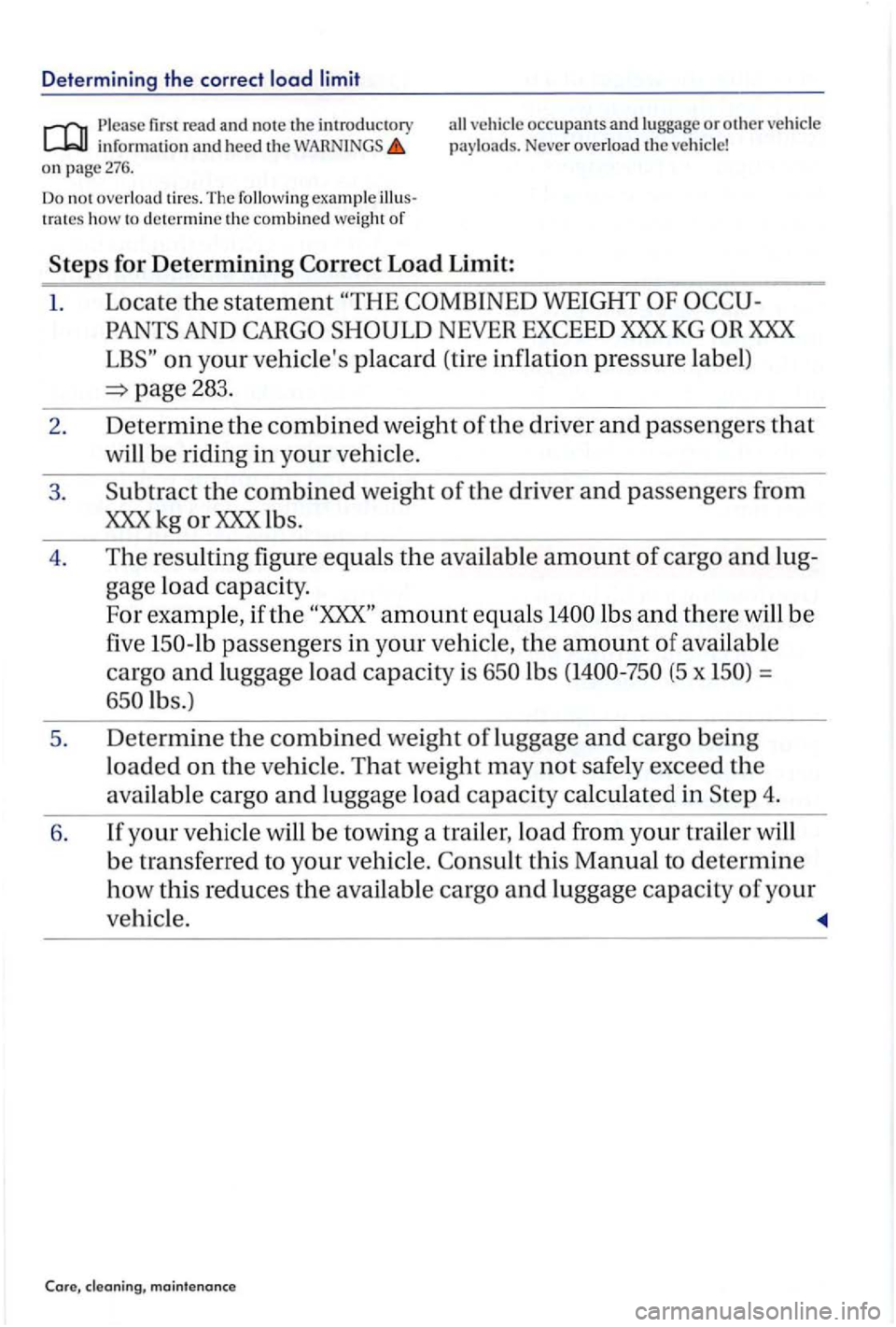
Determining the correct load limit
Please firs t read and note the introductory all ve hicle occupants and lu ggage or other ve hicl e inrormation and heed the pay loa ds. Neve r overload the ve hicle! on page 276.
Do no t over loa d tir es. The rollowi ng example trat es how to dete rm in e the combined we ight or
Load Limit:
1. Locate the statem ent
XXX KG XXX
on your ve hicle's placard (tire inflation pressure la b el)
lb s (5 x =
lb s.)
5. De
termine the combined weight of lu ggage and cargo being
loaded on the ve hicl e. That weight m ay not safely exceed the
ava
ilabl e cargo and lu ggage load capacity calculated in
maintenance
Page 370 of 541

Water under vehicle . . . . . . . . . . . . . . . . . 231
Wipers ............................. 129
S peed rating code le tter ................. 293
Stalling
Protecting th e ve hicle ................
S teering ...............................
Cou nter- steering support ............
E lectro-mechanical. . . . . . . . . . . . . . . . . .
Indicator light. ......................
to one side ................... 286 Servo steering .......................
Steering co lumn lock .... ............
Steering wheel
A dju sti
ng . . . . . . . . . . . . . . . . . . . . . . . . . . . . 63 S hift paddles (Ti ptron ic) . . . . . . . . . . . . . 185
Sticke rs . . . . . . . . . . . . . . . . . . . . . . . . . . . . . . . 311
Storage areas . . . . . . . . . . . . . . . . . . . . . . . . . .
storage compartments . . . . . . . . . 165
Overhead console . . . . . . . . . . . . . . . . . . . 161
manual. . . . . . . . . . . . . . . . . . . . . 16 3
Pa sse nge r sid e . . . . . . . . . . . . . . . . . . . . . . 16 3 Storage compartment light . . . . . . . . . . . 125
Stow ing luggage . . . . . . . . . . . . . . . . . . . . . . . 13 8
protection. . . . . . . . . . . . . . . . . . . . . . . . . 126
brak e sys tem (ABS) . . . . . . . . . 194
Regulation . . . . . . . . . . . . . . . . . 196
194
Launch control program . . . . . . . . . . . . . 186
Assis t . . . . . . . . . . . . . . . . . . . . . . . . . .
Distance Control. . . . . . . . . . . . . . . .
Rear Assist . . . . . . . . . . . . . . . . . . . . . . . . . .
C urb weight. . . . . . . . . . . . . . . . . . . . . . . . .
Dimensions. . . . . . . . . . . . . . . . . . . . . . . . . . 33
Displacement . . . . . . . . . . . . . . . . . . . . . . . . 32 E ngin e data an d dimensions . . . . . . . . . . 32
Engine oil specifications . . . . . . . . . . . . . 248
Filling capacity. . . . . . . . . . . . . . . . . . . . . . 132
Fu el capacities . . . . . . . . . . . . . . . . . . . . . . 237 Gross vehicle we ight. . . . . . . . . . . . . . . . .
.............................. 32
Roof load . . . . . . . . . . . . . . . . . . . . . . . . . . . 15 1
Sa fety Compliance Certif ic ation Label. . 3 1
Tir e pressure . . . . . . . . . . . . . . . 283 Tongue load . . . . . . . . . . . . . . . . . . . . . . . . 152 Weights . . . . . . . . . . . . . . . . . . . . . . . . . . . .
Technical modifica tions . . . . . . . . . . . . . . . .
temperature . . . . . . . . . . . . . . . . . . 17
Temperature gauge
E n gin e coolant . . . . . . . . . . . . . . . . . . . . . . 252
hooks........................ 146
T ighteni ng torque Whee l bo lts . . . . . . . . . . . . . . . . . . . . . . . . . 332
372 373
Page 371 of 541
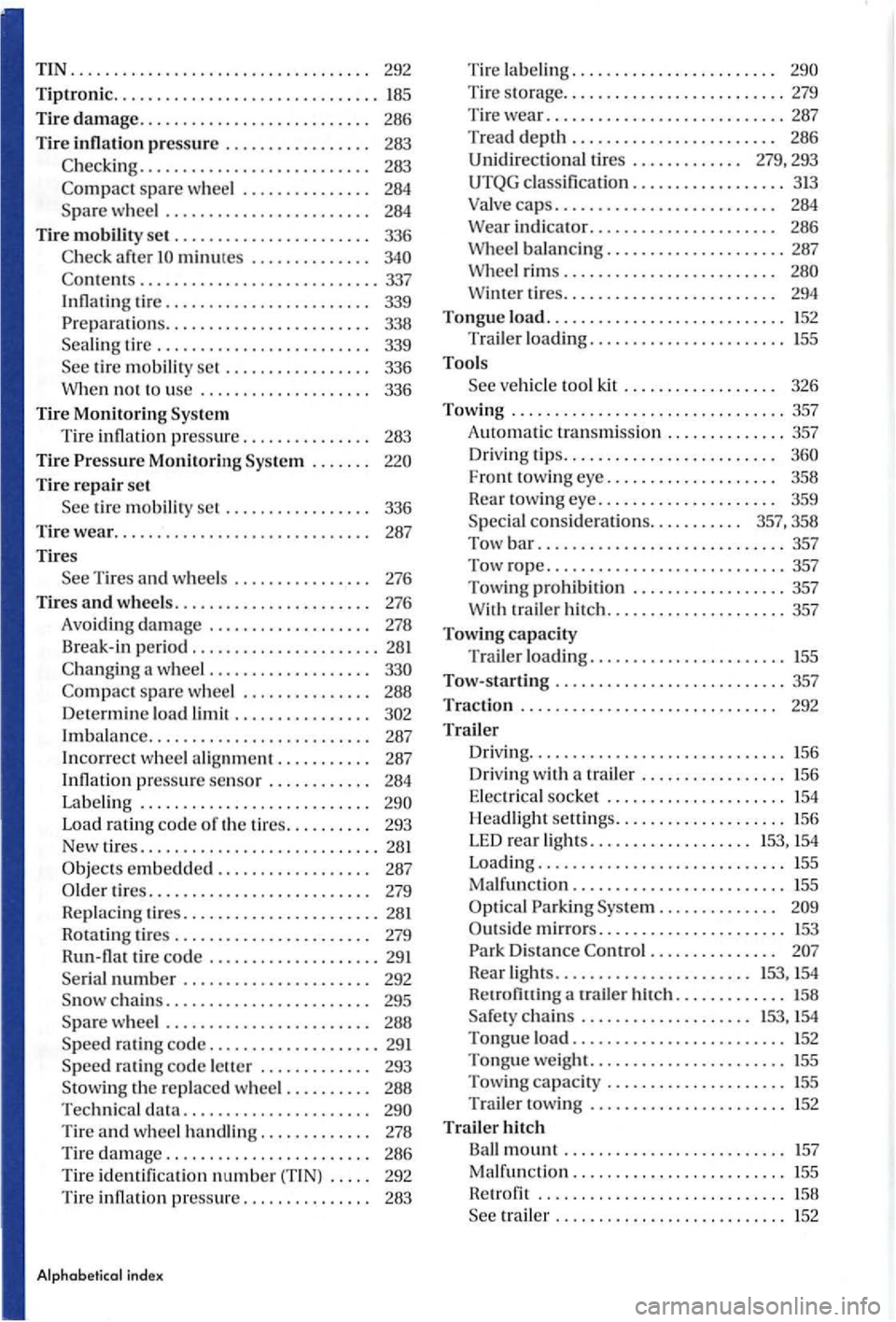
TIN .................................. .
292
Tiptronic ............................... 185
Tire damage.. . . . . . . . . . . . . . . . . . . . . . . . . . 286
Tire inflati on pressure . . . . . . . . . . . . . . . . . 283
. . . . . . . . . . . . . . . . . . . . . . . . . . 283
spare wheel . . . . . . . . . . . . . . . 284 Spare wheel . . . . . . . . . . . . . . . . . . . . . . . . 284
Tire mobility set . . . . . . . . . . . . . . . . . . . . . . . 336
minutes . . . . . . . . . . . . . .
tire m ob ilit y set . . . . . . . . . . . . . . . . . 336
no t to use . . . . . . . . . . . . . . . . . . . . 336
Tire Monitoring Sys tem
Tire inflati on
pressu re. . . . . . . . . . . . . . . 283
Tire Pressure Monitoring Sys te m . . . . . . .
Tire re p a ir set
tir e m ob ility se t . . . . . . . . . . . . . . . . . 336
Tire wear.. . . . . . . . . . . . . . . . . . . . . . . . . . . . . 287
Tires
T ires and w hee ls . . . . . . . . . . . . . . . . 276
Tires a
nd wheels....................... 276
Avoiding
damage . . . . . . . . . . . . . . . . . . . 278
Br eak- in period
...................... 281
spare w heel ............... 288
Determine load limit . . . . . . . . . . . . . . . .
Imbal ance.......................... 287
In co rrect wheel a lignment........... 287
I nflat io n pr essure
sensor . . . . . . . . . . . . 284
La beli n g . . . . . . . . . . . . . . . . . . . . . . . . . . .
Load rating code of th e tir es. . . . . . . . . . 293
New
tires .......................... .. 28 1
rat ing code letter . . . . . . . . . . . . . 293
the replaced w hee l . . . . . . . . . . 288
Technical data. . . . . . . . . . . . . . . . . . . . . . Tire an d wheel handling. . . . . . . . . . . . . 278
Tir e damage. . . . . . . . . . . . . . . . . . . . . . . . 286
T ire identifi ca
tion number (TIN) . . . . . 292
Ti re infl ation pressure............... 283
Alphabetical ind ex
Tir e lab eling. . . . . . . . .. .. . . . . .. . . . . .
balancing ..................... 287 rims. . . . . . . . . . . . . . . . . . . . . . . . .
tires. . . . . . . . . . . . . . . . . . . . . . . . . 294
Tongue load ............................ 152 Trailer loading ....................... 155
Tools
F ront tow ing eye.. . . . . . . . . . . . . . . . . . . 358
Rear towing
eye.. . . . . . . . . . . . . . . . . . . . 359
S pec ia l
consideratio ns. . . . . . . . . . . 357, 358
Tow b
ar ............................. 357
Tow rope ............................ 357
Towi ng prohibi
tion .................. 357 traile r hit ch ..................... 357
Towing
capacity
T railer loading ....................... !55
Tow- starting ........................... 357
Traction . . . . . . . . . . . . . . . . . . . . . . . . . . . . . . 292
Trailer Driving .............................. !56
D
riv ing w ith a trailer ................. !56
E lec tri
cal socke t ..................... !54 H ea dligh t settin gs .................... 156
L E D r
ear ligh ts. . . . . . . . . . . . . . . . . . . 153, !54
Loading ............................. 155
Malfunction ......................... 155
Pa rking System. . . . . . . . . . . . . .
. . . . . . . . . . . . . . .
Rear ligh ts ....................... 153, 154 Retrofitting a rrailer hitch ............. 158
Safety ch a ins . . . . . . . . . . . . . . . . . . . . !53, !54
Tongue load . . . . . . . . . . . . . . . . . . . . . . . . . 152 Tongue weight ....................... !55 Towing capacity ..................... 155
Trailer towing ....................... !52
Trail er hitch
Ball mount . . . . . . . . . . . . . . . . . . .. . . . . . . 157
Malfun ction ......................... 155
H etrofit ............................. 158
trail er . ................. ......... !52